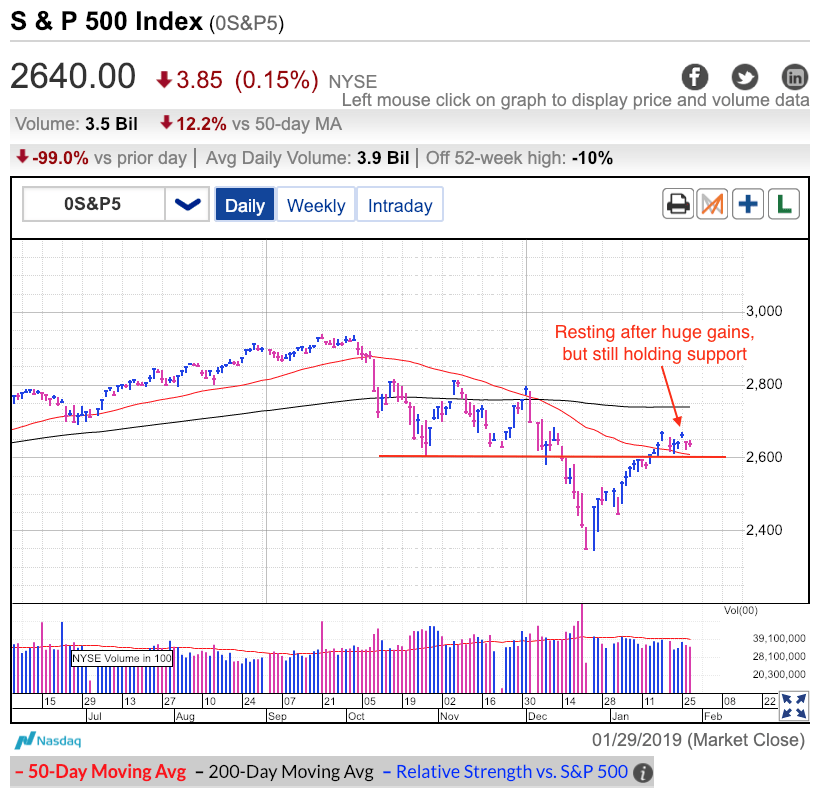
On Tuesday, the S&P 500 slipped fractionally, but more importantly, it continues holding this month’s 2,600 breakout.
Over the weekend, Trump and Congress agreed to a temporary budget that allowed government workers to return to work and collect back pay. That was a critical development for Federal workers who missed two paychecks, but the political situation is far from resolved and the market actually declined on Monday.
As I wrote last week, the 10% rally from the December lows priced in a lot of optimism that the problems triggering last month’s swoon would be resolved. Unfortunately, that also meant any compromise was already largely priced in and stocks actually fell Monday because our politicians only offered a temporary solution.
The other significant development is the U.S. government’s criminal probe into Huawei (SZ:002502), one of China’s most important companies. No doubt this escalates trade war tensions between these two economic superpowers.
Both of these events could be interpreted as bearish, and that’s the way the market took it, with declines on Monday and Tuesday, but the silver lining is the losses were relatively restrained. Taken together, the last two days of selling didn’t even trim 1% of value and we are still above the psychologically significant 2,600 level. Based on how volatile the previous three months has been, this week’s dip was barely a tremor.
I like how well the market is holding 2,600 support. Prices tumble from overbought and unsustainable levels quickly. This is our third week above this level and shows real demand for stocks at these prices. If equities were fragile and vulnerable to a tumble, there have been more than enough triggers to send us crashing back to the lows. Instead, the market shrugs the negativity off and continues holding recent gains. This is a dramatic improvement from late last year where even the smallest hint of a problem hiccup would send traders scrambling for the exits.
While the market’s mood has done a 180, its not that investors changed their minds, but that we changed investors. Fearful owners sold their stocks at a steep discount to confident dip buyers willing to hold these risks. After enough turnover takes place, we run out of fearful sellers and confident dip buyers disregard flare-ups of recycled headlines. That’s how we go from 250-point free falls to 300-point rebounds.
The problem with 300-point rebounds is the rate of gains is clearly not sustainable for any length of time. And this two-week consolidation above 2,600 support is proof of that. The market needs a breather and there are two ways this plays out: the dramatic stepback, or a mind-numbing sideways grind. One scares weak traders out, the other bores them out.
To this point the market has resisted invitations to pull back. Big money seems more interested in buying these discounts than selling the fear and that is keeping a floor under prices. But at the same time, big money hates chasing prices higher and we can see their reluctance show up in the stalled rebound. In many ways, their reluctance to buy after a big move higher is a self fulfilling prophecy that creates the very dip they are worried about. But given how well the market is trading, most likely any near-term dip will be a buying opportunity.
While there is no reason to abandon our favorite long-term investments, there is also no reason to chase prices higher. Either we dip under 2,600 over the next few days or weeks, or we trade sideways for a while. Neither setup creates a good short-term buy. Instead, we should be patient and wait for a better entry.
If the market fails to rally on good news and finishes at the lows for a few days in a row, that is a bearish signal and an inviting short entry. If prices fall under 2,600 support, but quickly find a bottom, then that is our signal to buy the dip. And if we keep grinding sideways, then we just sit and watch. We only want to hold the risk of owning stocks when we are getting paid for it. If stocks are drifting sideways, we’re not getting paid and should be watching safely from the sidelines. We only want to buy when the risk/reward is stacked in our favor and that is not the case at these levels.
Apple (NASDAQ:AAPL) yesterday reported its first declining revenue and earnings in more than a decade. But everyone knew this was coming and it's why the stock was down nearly 40% from the highs. But the thing about the risks is they were already incorporated into the price. And like most things in the market, it probably even over did it.
If after-hours trade is any indication, AAPL will pop nicely today as reality turns out less bad than feared. If these gains stick Wednesday, it would put AAPL at the highest levels in over a month and easily erase the early January tumble when Apple lowered its guidance. At this point, it looks like that dreadful day when the crowd was rushing for the exits was actually one of the best entry points in over a year.
This is what I told subscribers the day after AAPL lowered guidance and the stock plunged to fresh lows:
“I suspect we have already heard the worst from AAPL and things will only improve from here. Hopefully, Tim Cook was smart enough to lower expectations so far yesterday that it will create an easy beat when they report earnings at the end of the month. With the worst of the bad news already out there, most likely things will start getting better from here. Even AAPL bears should be expecting a near-term bounce from these oversold levels.”
Since then, AAPL is up 15% from those lows.
